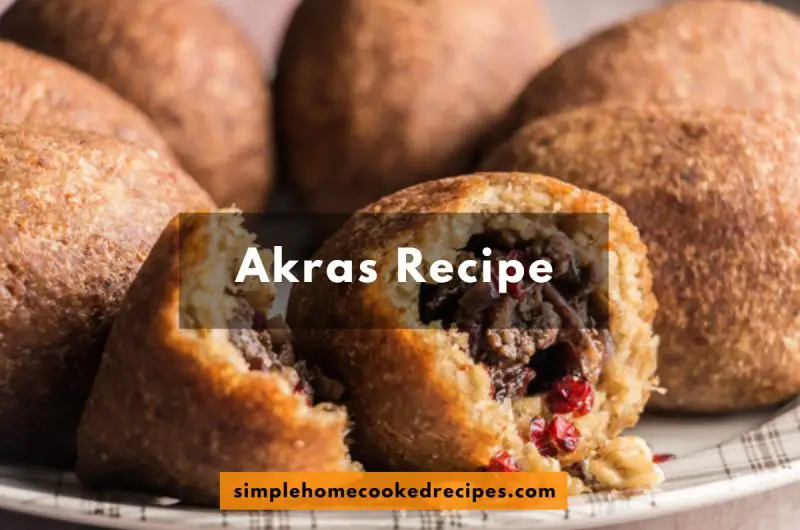
This Akras recipe is believed to have originated in Nigeria. It is, however, a very versatile dish that can be customized to suit individual tastes. Some people add spicy peppers and other vegetables to the mixture to make it more savory. Others would like to add honey to make this Akras recipe sweeter.
What Are Akras – Everything You Need To Know:
Akras, also known as bean cakes in English, are a popular snack in West Africa, especially in Nigeria, Ghana and Togo. They are made up of black eyed peas that are ground into a mixture, seasoned with a variety of spices and then deep fried till golden and crispy.
Akras food can be enjoyed on its own as a snack or served with other dishes such as porridge as a side. Akras is a good choice of a snack due to its high nutritional value. Akras Caribbean food is rich in protein, fiber, and other essential nutrients.
Akras Ingredients
- 2 cups Black Eyed Peas: Black eyed peas are the essential part of this Akras recipe. If black-eyed beans are unavailable, you can use other types of beans such as pinto beans, or chickpeas.
- 1 Small Onion: Make sure the onions in this Akras recipe are finely chopped and there are no large chunks.
- 1 Scotch Bonnet Pepper: Make sure the scotch bonnet pepper is seeded and chopped finely. You can also use jalapeno peppers instead of scotch bonnet pepper.
- 1 tsp Paprika: Paprika gives this Akras recipe a spicy edge.
- 1 tsp Ground Cumin: Cumin is good seasoning for this Akras recipe.
- 1/2 tsp Baking Powder: Baking powder helps the Akras get the crunchy texture and fry well.
- Salt: Add salt for seasoning according to your taste.
- Vegetable Oil: You can use vegetable oil or canola oil for frying in this Akras recipe. Make sure to use a neutral tasting oil.
How To Make Akras?
- Soak the black eyed peas in water and keep them there overnight.
- Drain the water from the beans and add them to a food processor. Pulse until the black eyed peas are coarsely ground. .
- Add the chopped onions, scotch bonnet pepper to the food processor in addition to the beans. Blend until the mixture is smooth.
- Transfer the bean mixture to a mixing bowl and add salt, ground cumin, paprika and baking powder. Mix well to combine.
- Heat the vegetable oil in a large frying pan over medium high heat. Using a tablespoon, scoop up the bean mixture and carefully drop it into the hot oil.
- Repeat the same process till the frying pan is full. Make sure the frying pan is not too overcrowded.
- Fry the akras for 2-3 minutes on each side or until golden brown and crispy.
- Use a slotted spoon to remove the akras from the hot oil and place them on a plate lined up with paper towels in order to remove the excess oil.
- Repeat the same process till of the mixture is used.
- Serve the akras hot with a choice of dipping sauce or enjoy this Akras recipe on its own.
Also Try: Cinnamon Swirl Recipe: Sweet – Twirly Delight

Tips To Make The Best Akras Food
Make sure to follow these tips and tricks for the best possible results on this Akras recipe:
- Make sure to soak the black eyed beans in water for several hours or overnight. This will help soften them and result in a softer mixture.
- Make sure the temperature of the oil is perfect for frying. If the oil is too hot, the Akras will absorb too much oil and become too greasy. The best way to check the oil’s temperature is to drop a small amount of mixture into the oil. If it sizzles in the oil and floats to the surface, the oil is ready.
- Make sure not to overcrowd the Akras in the frying pan.
- After the Akras are crispy and golden, take them out of the oil and place them on a plate lined up with paper towels to drain all the excess oil.
Akras Recipe FAQs
What are Akras?
Akras, also known as bean cakes in English, are a popular snack in West Africa, especially in Nigeria, Ghana and Togo. They are made up of black eyed peas that are ground into a mixture, seasoned with a variety of spices and then deep fried till golden and crispy.
How long can you store Akras for?
Akras can be stored in an airtight container for 3 to 4 days in the refrigerator. However, Akras are best served hot and thus it is recommended to serve them immediately after frying.
What are some variations in the seasoning for Akras?
The seasoning for this Akras recipe can be varied according to your taste and preference. You can add chopped vegetables to the mixture to make the flavor more savory. However, some people also add honey to the bean mixture to make the Akras sweeter.
What can Akras be served with?
Akras can be served with a variety of different foods as a side. For breakfast, Akras can be served with oatmeal as a side to make a nutritious breakfast. It can be used as a topping for salad or added to soup as a good protein source.
Akras Recipe Card
Akras Recipe: An Irresistible Caribbean Delight
Course: Snacks, AppetizersCuisine: African, NigerianDifficulty: Medium4
servings30
minutes20
minutes150
kcalIngredients
2 cups Black Eyed Peas
1 Small Onion
1 Scotch Bonnet Pepper
1 tsp Paprika
1 tsp Ground Cumin
1/2 tsp Baking Powder
Salt
Vegetable Oil
Directions
- Soak the black eyed peas in water and keep them there overnight.
- Drain the water from the beans and add them to a food processor. Pulse until the black eyed peas are coarsely ground. .
- Add the chopped onions, scotch bonnet pepper to the food processor in addition to the beans. Blend until the mixture is smooth.
- Transfer the bean mixture to a mixing bowl and add salt, ground cumin, paprika and baking powder. Mix well to combine.
- Heat the vegetable oil in a large frying pan over medium high heat. Using a tablespoon, scoop up the bean mixture and carefully drop it into the hot oil.
- Repeat the same process till the frying pan is full. Make sure the frying pan is not too overcrowded.
- Fry the akras for 2-3 minutes on each side or until golden brown and crispy.
- Use a slotted spoon to remove the akras from the hot oil and place them on a plate lined up with paper towels in order to remove the excess oil.
Recipe Video
Nutrition Facts
4 servings per container
- Amount Per ServingCalories150
- % Daily Value *
- Total Fat
8g
13%
- Cholesterol 68mg 23%
- Sodium 520mg 22%
- Potassium 36mg 2%
- Total Carbohydrate
40g
14%
- Dietary Fiber 2g 8%
- Sugars 20g
- Protein 4g 8%
* The % Daily Value tells you how much a nutrient in a serving of food contributes to a daily diet. 2,000 calories a day is used for general nutrition advice.


